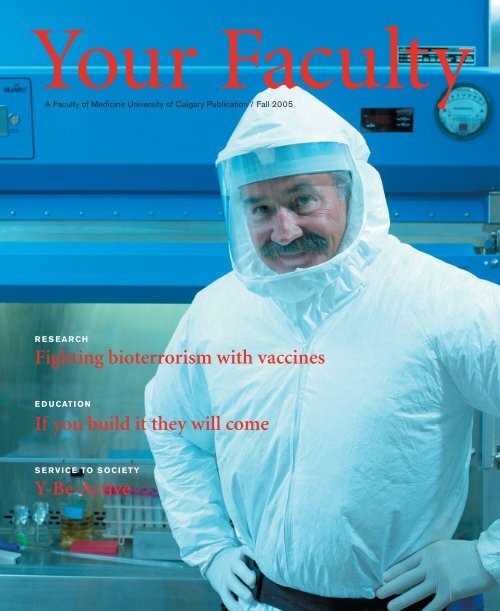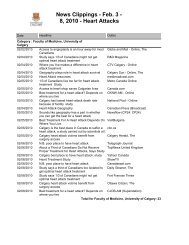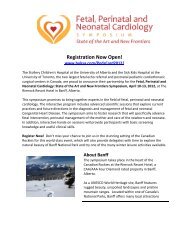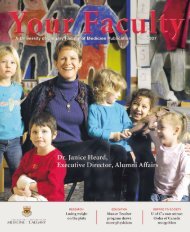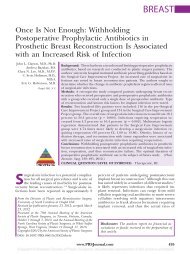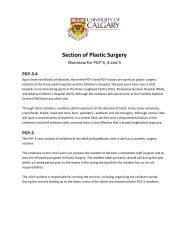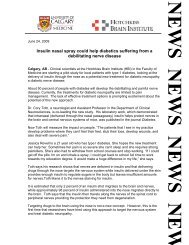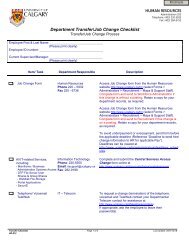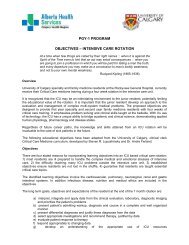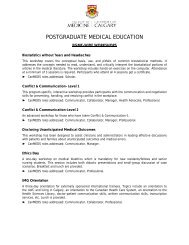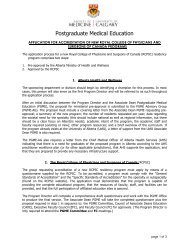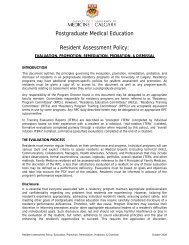Your Faculty / Fall 2005 - Faculty of Medicine - University of Calgary
Your Faculty / Fall 2005 - Faculty of Medicine - University of Calgary
Your Faculty / Fall 2005 - Faculty of Medicine - University of Calgary
Create successful ePaper yourself
Turn your PDF publications into a flip-book with our unique Google optimized e-Paper software.
<strong>Your</strong> <strong>Faculty</strong><br />
A <strong>Faculty</strong> <strong>of</strong> <strong>Medicine</strong> <strong>University</strong> <strong>of</strong> <strong>Calgary</strong> Publication / <strong>Fall</strong> <strong>2005</strong><br />
R E S EAR CH<br />
Fighting bioterrorism with vaccines<br />
E D U CATI ON<br />
If you build it they will come<br />
S E RVI CE TO S OCI ETY<br />
Y-Be-Active
<strong>Your</strong> <strong>Faculty</strong><br />
Vol 2 Issue 1 / <strong>Fall</strong> <strong>2005</strong><br />
<strong>Your</strong> <strong>Faculty</strong> is published three times<br />
a year by the <strong>Faculty</strong> <strong>of</strong> <strong>Medicine</strong><br />
<strong>University</strong> <strong>of</strong> <strong>Calgary</strong>, providing news<br />
and information for and about our faculty,<br />
staff, alumni, friends and community.<br />
For more information contact:<br />
Executive Editor<br />
Gail Corbett<br />
T 403.210.3894<br />
E corbettg@ucalgary.ca<br />
Managing Editor<br />
Natalie St-Denis<br />
Dean<br />
Dr. D. Grant Gall<br />
Vice Dean<br />
Dr. Pam Sokol<br />
Associate Deans<br />
Dr. Martin Atkinson<br />
Clinical Affairs<br />
Dr. Benedikt Hallgrímsson<br />
Undergraduate Science Education<br />
Dr. Richard Hawkes<br />
Research<br />
Dr. Taj Jadavji<br />
International Health<br />
Dr. Allan Jones<br />
Undergraduate Medical Education<br />
Dr. Doug Myhre<br />
Rural & Regional Affairs<br />
Dr. Jill Nation<br />
Postgraduate Medical Education<br />
Dr. Frans van der Hoorn<br />
Graduate Science Education<br />
Dr. Bruce Wright<br />
Continuing Medical Education<br />
Vision<br />
Creating the future <strong>of</strong> health<br />
Mission<br />
An innovative medical school committed<br />
to excellence and leadership in education,<br />
research and service to society.<br />
Design and Art Direction<br />
COMBINE Design & Communications<br />
www.combine-online.com<br />
Photography<br />
John Gaucher Images<br />
unless otherwise noted.<br />
F A C U L T Y O F<br />
MEDICINE<br />
U N I V E R S I T Y O F<br />
CALGARY
Contents Vol 2 Issue 1 / <strong>Fall</strong> <strong>2005</strong><br />
02 The power <strong>of</strong> partership / Message from the Dean<br />
03 Creating the future <strong>of</strong> health and wellness / New Initiatives<br />
><br />
04 Fighting bioterrorism with vaccines / Research<br />
06 If you build it they will come / Education<br />
Taking medical care to rural Alberta<br />
08 Y-Be-Active / Service to Society<br />
Investigating activity levels in preschoolers<br />
10 New mountain medicine program / International<br />
First <strong>of</strong> its kind in the world<br />
12 Mouse Prion Initiative / Research<br />
Investigating genetic mutations and protein misfolding<br />
13 Landmark study changes treatment strategy<br />
for specific heart condition / Alumni Pr<strong>of</strong>ile<br />
14 Our People<br />
> ON THE COVER:<br />
Dr. Donald Woods, a researcher in microbiology and<br />
infectious diseases, is putting science to work in the<br />
fight against biological warfare.<br />
PHOTO ABOVE:<br />
Dr. Marc Poulin, a physiology and biohysics pr<strong>of</strong>essor<br />
in the <strong>Faculty</strong> <strong>of</strong> <strong>Medicine</strong> is helping spearhead the<br />
world’s first mountain medicine program.
2<br />
Message from the Dean<br />
<strong>Your</strong> <strong>Faculty</strong> / <strong>Fall</strong> <strong>2005</strong><br />
Dr. D. Grant Gall<br />
PHOTO: COURTESY OF THE FACULTY OF MEDICINE<br />
><br />
The power <strong>of</strong> partnership<br />
A<br />
s friends and family <strong>of</strong> the <strong>Faculty</strong> <strong>of</strong> <strong>Medicine</strong>, you already know the strength inherent in solid<br />
partnerships. In some way, shape or form, I bet each <strong>of</strong> you reading this is part <strong>of</strong> a <strong>Faculty</strong> <strong>of</strong> <strong>Medicine</strong><br />
partnership in action.<br />
Perhaps you belong to a group <strong>of</strong> first-year MD students quickly discovering the value in forming<br />
study groups to better digest the volumes <strong>of</strong> information coming your way. Or, you may be one <strong>of</strong> 1,500<br />
fulltime and clinical faculty members team-teaching students in classrooms, clinics and hospitals throughout<br />
<strong>Calgary</strong> and southern Alberta. Maybe you are an alumna or donor whose legacy is the consistent<br />
presence <strong>of</strong> your support. <strong>Your</strong> individual contributions to the <strong>Faculty</strong> <strong>of</strong> <strong>Medicine</strong> – whether student,<br />
faculty, staff, alumnus, donor or community supporter – make you an ongoing partner in our commitment<br />
to leadership and excellence in education, research and service to society.<br />
Capitalizing on the power <strong>of</strong> partnership, we’re pioneering three unique collaborative initiatives<br />
that encourage individuals and groups with common goals to put our collective heads together to grow<br />
and enhance what is possible for the future <strong>of</strong> the <strong>Faculty</strong> <strong>of</strong> <strong>Medicine</strong> and health care as a whole.<br />
U <strong>of</strong> C and CHR – Partners in development<br />
To support the future activities <strong>of</strong> our research institutes and to underpin excellence in education, research<br />
and clinical care, the <strong>University</strong> <strong>of</strong> <strong>Calgary</strong> has partnered with the <strong>Calgary</strong> Health Region in an ambitious<br />
joint fundraising initiative to raise $300 million in health philanthropy. Over the next three years, we will<br />
invite community leaders to invest in the people, programs and technological advances that will see<br />
<strong>Calgary</strong> set new world standards <strong>of</strong> health.<br />
><br />
><br />
Province <strong>of</strong> Alberta, <strong>Faculty</strong> <strong>of</strong> <strong>Medicine</strong> and rural health care practitioners – Partners in people<br />
Dr. Doug Myhre is our new associate dean, Rural & Regional Affairs, here at the faculty. In this newly<br />
created position, Dr. Myhre leads the <strong>Faculty</strong> <strong>of</strong> <strong>Medicine</strong>’s involvement in Alberta’s Rural Physician<br />
Action Plan, designed to bolster medical education, recruitment and retention for this province’s rural<br />
communities (see page 6 for more on this partnership).<br />
U <strong>of</strong> C’s health sciences faculties – Partners in education<br />
Finally, we intend to prove that the whole is greater than the sum <strong>of</strong> its parts with the creation <strong>of</strong> the<br />
<strong>University</strong> <strong>of</strong> <strong>Calgary</strong>’s Division <strong>of</strong> Health Sciences (see next page). Within this framework, the Faculties<br />
<strong>of</strong> Kinesiology, <strong>Medicine</strong>, Nursing, Social Work and Veterinary <strong>Medicine</strong> will create the future <strong>of</strong> health<br />
and wellness, cooperating closely in undergraduate and graduate teaching, research training and ensuring<br />
that research outcomes benefit the wider community.<br />
As you peruse the pages <strong>of</strong> this issue <strong>of</strong> <strong>Your</strong> <strong>Faculty</strong>, think about the many ways strong partnerships are<br />
manifesting themselves within the <strong>Faculty</strong> <strong>of</strong> <strong>Medicine</strong>, and their powerful results.<br />
D. Grant Gall, m d, f rc p c<br />
Dean
<strong>Your</strong> <strong>Faculty</strong> / <strong>Fall</strong> <strong>2005</strong><br />
New Initiatives<br />
3<br />
Creating the future<br />
<strong>of</strong> health and wellness<br />
PHOTO: MIKAEL KJELLSTROM REPRINTED WITH PERMISSION OF THE CALGARY HERALD<br />
U <strong>of</strong> C student Heather Fedor<br />
W<br />
ith its vision to create the future <strong>of</strong> health and wellness, the Faculties<br />
<strong>of</strong> Kinesiology, <strong>Medicine</strong>, Nursing, Social Work and Veterinary<br />
<strong>Medicine</strong> have partnered to create the Division <strong>of</strong> Health Sciences<br />
– an initiative that encourages a collaborative approach to providing<br />
education and research opportunities for students and faculty.<br />
“This new division furthers the university’s goal <strong>of</strong> encouraging<br />
faculties to work together under our established pillars <strong>of</strong> excellence,”<br />
says President Harvey Weingarten. “The Health and Wellness pillar<br />
will be well served by the synergies created as these faculties develop<br />
innovative education and research opportunities that further our<br />
academic plan.”<br />
The division’s executive management committee (EMC) will be<br />
led by Dr. Grant Gall as executive dean, and Paul Heinrich as chief<br />
operating <strong>of</strong>ficer. Other key members are Dr. Michael Clinton, dean<br />
<strong>of</strong> nursing, Dr. Gayla Rogers, dean <strong>of</strong> social work, Dr. Tina Gabriele,<br />
vice dean <strong>of</strong> kinesiology, Dr. Peter Eyre, interim dean <strong>of</strong> veterinary<br />
medicine, and a representative from the <strong>Calgary</strong> Health Region.<br />
“I am delighted to work with my colleagues on this initiative<br />
as each <strong>of</strong> us brings a great deal <strong>of</strong> insight and commitment to the<br />
creation <strong>of</strong> the division,” says Gall. “For the past several months,<br />
we have explored ways to work collaboratively to develop internationally<br />
recognized education, research, leaders and services that will<br />
help create healthy communities.”<br />
This initiative will result in the <strong>Faculty</strong> <strong>of</strong> Nursing moving to the<br />
Health Sciences Complex, marking an exciting new chapter in its<br />
development. “The formation <strong>of</strong> the Division <strong>of</strong> Health Sciences<br />
creates opportunities for the <strong>Faculty</strong> <strong>of</strong> Nursing to contribute to major<br />
inter-pr<strong>of</strong>essional developments in teaching, research and service<br />
to the community that are without parallel in its 35-year history at<br />
the <strong>University</strong> <strong>of</strong> <strong>Calgary</strong>,” remarks Clinton. “With the creation <strong>of</strong> the<br />
division, we have entered a new era in which nursing can demonstrate<br />
that it has come <strong>of</strong> age as a mature academic discipline.”<br />
All faculties will continue to operate independently but will seek<br />
opportunities to collaborate and innovate as a collective. Several interfaculty<br />
task forces have been formed to explore collaborative, divisional<br />
initiatives to achieve excellence in education and research.<br />
“Creating an alliance among the health science faculties is exciting<br />
because the opportunities for creating excellence in educational,<br />
scholarly and service activities are significant,” says Gabriele. “The work<br />
to date has been highly collegial, inspiring and productive – I look<br />
forward to our future collaborations.”<br />
“It’s critically important for the social dimensions <strong>of</strong> health to be<br />
considered when creating a health sciences division,” says Dr. Gayla<br />
Rogers, dean <strong>of</strong> social work. “That’s why our faculty is excited to be<br />
involved in this initiative – we bring to the table a strong commitment<br />
to the social determinants <strong>of</strong> health, which will significantly add to<br />
the holistic vision <strong>of</strong> this division.”
4<br />
Research <strong>Your</strong> <strong>Faculty</strong> / <strong>Fall</strong> <strong>2005</strong><br />
Dr. Donald E. Woods<br />
Fighting bioterrorism with vaccines<br />
By Doug McLaughlin<br />
B<br />
ioterrorism. Biological warfare. If the average Canadian thinks <strong>of</strong><br />
these terms at all, it is probably with disquiet, even dismay. The notion<br />
itself is repellent: killing people with disease – intentionally, at random<br />
– with planning and science, forethought and subterfuge.<br />
In exploring this topic, one finds that using deadly sickness as a<br />
weapon is neither a modern aberration nor one confined to desperate<br />
foreign sects from some distant, dusty land. And, while most <strong>of</strong> us<br />
feel a large measure <strong>of</strong> helplessness in the face <strong>of</strong> such an invisible<br />
and deadly threat, science is examining both the problem and the<br />
solution with great concentration.<br />
A significant element <strong>of</strong> that science is taking shape right here<br />
in Alberta, at the <strong>University</strong> <strong>of</strong> <strong>Calgary</strong>.<br />
Dr. Donald E. Woods, pr<strong>of</strong>essor <strong>of</strong> microbiology and infectious<br />
diseases, Canada Research Chair in Microbiology, is heading up<br />
this research. From his laboratory in the Health Sciences Centre in<br />
<strong>Calgary</strong>, he links with other facilities across North America and the<br />
world, sharing results, ideas, data and inspiration, battling potential<br />
disease outbreaks.<br />
“We study the pathogens, try to figure out how they might be<br />
‘weaponized’, devise an effective vaccine – which is then put on a shelf,<br />
in the hope that it is never needed,” says Woods.<br />
Woods joined the Department <strong>of</strong> Microbiology and Infectious<br />
Diseases at U <strong>of</strong> C’s <strong>Faculty</strong> <strong>of</strong> <strong>Medicine</strong> in 1982. In 1988, he began<br />
unraveling the biological components <strong>of</strong> a disease that affects the<br />
Dr. Woods earned his Ph.D. in microbiology from the <strong>University</strong> <strong>of</strong> Texas Health Sciences Centre, completed a postdoctoral research fellowship in Oregon,<br />
and joined the Department <strong>of</strong> Microbiology and Infectious Diseases at U <strong>of</strong> C’s <strong>Faculty</strong> <strong>of</strong> <strong>Medicine</strong> in 1982. He became chair <strong>of</strong> the department and full<br />
pr<strong>of</strong>essor in 1991; in 1996 he became the scientific director <strong>of</strong> the Canadian Bacterial Diseases Network, an organization associated with the Network
<strong>Your</strong> <strong>Faculty</strong> / <strong>Fall</strong> <strong>2005</strong><br />
Research<br />
5<br />
people <strong>of</strong> Southeast Asia. The disease, known as melioidosis, is caused by a bacterial organism closely<br />
related to one that Woods has worked with for many years.<br />
“As very little was known about the organism and the disease melioidosis, I felt challenged to pursue<br />
these basic studies to define how the organism causes disease and then develop new therapeutic approaches,”<br />
says Woods.<br />
Burkholderia pseudomallei, commonly known as melioidosis (or Whitmore’s disease), can result in<br />
pneumonia, many painful and debilitating symptoms, and become chronic if left untreated. The bacteria<br />
live in soil and water and can enter the body through cuts and abrasions, a common occurrence in agricultural<br />
workers, who spend a great deal <strong>of</strong> time wading in rice paddies. This disease also became known<br />
among helicopter aircrew during the Vietnam War, who contracted it through their pulmonary systems<br />
when the organisms were carried in dust stirred up by the downwash from their machines.<br />
Fortunately for those who have access to antibiotics, melioidosis can be cured, but the number <strong>of</strong> effective<br />
antibiotics is limited. Immunization with an effective vaccine would prevent a tremendous amount <strong>of</strong><br />
suffering and early death and Woods believes he has the key to this immunization. “We have developed<br />
a multi-component vaccine; it contains three components from the bacterium that have been extracted,<br />
purified and detoxified. This vaccine has shown promise in preliminary studies as an effective preventative<br />
against melioidosis,” explains Woods.<br />
When he speaks <strong>of</strong> the science <strong>of</strong> assembling this vaccine, his enthusiasm over the technical achievement<br />
<strong>of</strong> his team is tempered by the reality <strong>of</strong> the years <strong>of</strong> testing and verification ahead, the process to which<br />
all new medicines are subjected. However, the formulation <strong>of</strong> this vaccine itself could be a significant step<br />
towards the solution to at least one other virulent infection, glanders.<br />
Closely related to melioidosis, glanders is a more widespread disease with a history <strong>of</strong> use in biological<br />
warfare going back to the 19th century. Primarily affecting livestock, it falls into the category <strong>of</strong> zoonotic,<br />
a disease <strong>of</strong> animals that can be transmitted to humans (other examples are anthrax, equine encephalitis<br />
and rabies). Zoonotic diseases sometimes acquire an extra vigor in human hosts, and both melioidosis<br />
and glanders are regarded as potential agents for biological warfare and bioterrorism.<br />
The work conducted by Woods and his research staff has little glamour connected with it. It involves<br />
the repetitive, never-ending testing <strong>of</strong> small elements <strong>of</strong> the problem, chasing after possibilities that more<br />
<strong>of</strong>ten than not lead to dead-ends. And the simple fact <strong>of</strong> working in the faculty’s Level Three Containment<br />
Laboratory is a chore in itself – changing, showering, and ensuring that every precaution <strong>of</strong> the security<br />
routine is followed – both on the way in and on the way out.<br />
Every bit <strong>of</strong> it will be worthwhile if the product – the vaccine – is ever needed. On the other hand,<br />
Woods will be perfectly happy if it is never put to the test. “Even if my colleagues and I have invested<br />
countless hours and effort in the development <strong>of</strong> a vaccine against these biowarfare/bioterrorism agents,<br />
we hope that the vaccine will never be necessary, and that it will serve as a deterrent to those considering<br />
the use <strong>of</strong> these particular biological agents for unspeakable acts against humanity,” says Woods.<br />
B i o lo g i c a l W a r fa r e<br />
The Geneva Protocol, signed by<br />
108 nations in 1925, was the first<br />
multilateral agreement prohibiting<br />
biological weapons. Biological<br />
weapons include any organism or<br />
toxin found in nature that can be<br />
used to incapacitate, kill, or otherwise<br />
impede an adversary. From Spain<br />
to Japan, countries worldwide have<br />
experienced several incidences<br />
<strong>of</strong> bioterrorism in recent history.<br />
The most prominent, from a North<br />
American point <strong>of</strong> view, occurred in<br />
the immediate post-9/11 period from<br />
September to November 2001; a total<br />
<strong>of</strong> 23 confirmed or probable cases<br />
<strong>of</strong> terrorist-related anthrax dispersion<br />
occurred in the United States.<br />
<strong>of</strong> Centres <strong>of</strong> Excellence Program <strong>of</strong> Canada. In 2002, Woods returned to his former post, choosing to concentrate on his research program as Canada<br />
Research Chair in Microbiology. He has published more than 130 peer-reviewed manuscripts, 10 book chapters and 100 abstracts.
6 Education<br />
<strong>Your</strong> <strong>Faculty</strong> / <strong>Fall</strong> <strong>2005</strong><br />
Dr. Doug Myhre<br />
If you build it they will come<br />
Taking medical care to rural Alberta<br />
By Alison Azer<br />
D<br />
r. Doug Myhre doesn’t need artwork to liven up his new <strong>Calgary</strong><br />
<strong>of</strong>fice. Recently appointed associate dean, Rural & Regional Affairs<br />
for the <strong>Faculty</strong> <strong>of</strong> <strong>Medicine</strong>, Myhre looks out onto an urban cityscape<br />
<strong>of</strong> scaffolds, hard hats and forklifts. When asked if his surroundings<br />
clash with his rural sensibilities, he laughs: “We work in parallel –<br />
building and creating.”<br />
In fact, the construction-site-view <strong>of</strong>f Myhre’s new <strong>of</strong>fice is entirely<br />
fitting. This man’s a mover and shaker in Alberta rural health care.<br />
And like the faculty he’s joined, Myhre is a builder.<br />
Jointly funded by the U <strong>of</strong> C <strong>Faculty</strong> <strong>of</strong> <strong>Medicine</strong> and The Alberta<br />
Rural Physician Action Plan (RPAP), the new position in Rural &<br />
Regional Affairs is designed to help the government and university<br />
meet the health care needs <strong>of</strong> rural Albertans and their physicians.<br />
The position is a timely response to a larger provincial plan designed<br />
to address a growing need identified by the Alberta government:<br />
to educate, recruit and retain rural physicians in Alberta.<br />
Rural health care is a vital part <strong>of</strong> keeping Alberta’s small towns<br />
alive. A town without a physician just isn’t sustainable. The presence<br />
<strong>of</strong> good health care helps stabilize smaller communities. But it’s not<br />
as simple as dropping a well-trained physician in to a remote corner<br />
<strong>of</strong> Alberta. Because rural physicians must respond to a wide range <strong>of</strong><br />
patient care demands, lack <strong>of</strong> immediate access to the larger medical<br />
community, technology and expertise <strong>of</strong>ten makes life as a rural doctor<br />
a trying and isolating experience Physicians must work within a larger<br />
medical context.<br />
When not commuting between Lethbridge and <strong>Calgary</strong>, Dr. Doug Myhre enjoys woodworking, hiking, downhill skiing, and spending lots <strong>of</strong> time on his<br />
boat – taking friends and family water skiing. He has also made fundraising an integral part <strong>of</strong> his life. Over the years he has been actively involved with<br />
the Lethbridge Community College Foundation, the <strong>University</strong> <strong>of</strong> Lethbridge Foundation, and is currently with the Lethbridge Community Foundation.
<strong>Your</strong> <strong>Faculty</strong> / <strong>Fall</strong> <strong>2005</strong><br />
Education 7<br />
As the faculty’s first associate dean <strong>of</strong> Rural & Regional Affairs, one <strong>of</strong> his roles is to identify and represent<br />
rural needs to the <strong>Faculty</strong> <strong>of</strong> <strong>Medicine</strong> and to help the faculty provide service to rural communities.<br />
His guiding principle: “Let’s open the doors for communicating our needs and hopes and put our shoulders<br />
to the wheel collectively.”<br />
Working collaboratively with the teaching and medical communities across Alberta, Myhre and his<br />
Northern counterpart, Dr. Jill Konkin, who heads up U <strong>of</strong> A’s Rural and Regional Health initiative, will<br />
build a province-wide network <strong>of</strong> health care resources, pr<strong>of</strong>essionals, and infrastructure to address the<br />
needs <strong>of</strong> physicians working in rural communities. In cooperation with the medical faculty, they will<br />
develop new admissions and curricular policies that will encourage young people from rural communities<br />
to apply to medical school and that will see more young doctors take their practices to rural settings.<br />
One <strong>of</strong> the best ways to prepare physicians for the challenges <strong>of</strong> rural practice is to train them in a rural<br />
setting. Plans for new distant learning programs, continuing medical education programs, a database <strong>of</strong><br />
rural residency placements, upgrades to rural clinics to make them suitable for teaching and learning are<br />
in the works.<br />
Myhre brings an impressive portfolio <strong>of</strong> knowledge and experience to the job.<br />
Working with Hinton physician Dr. Hugh Hindle, Myhre established RPAP’s Alberta Rural Family<br />
<strong>Medicine</strong> Network (ARFM) in 2000, a program that helps place young family doctors in rural settings for<br />
their residencies. As inaugural unit directors for Rural Alberta South (RAS) and Rural Alberta North (RAN)<br />
respectively, Myhre and Hindle, worked collaboratively to build relationships between the teaching universities<br />
and the rural and regional medical communities <strong>of</strong> Alberta. “I was guided by a desire for medical students<br />
and universities to know <strong>of</strong> the good quality medicine practiced in rural Alberta, and for physicians,<br />
working in these communities, to know that universities will respond to their needs,” says Myhre.<br />
“Doug’s experience as Rural Alberta South (RAS) unit director and community physician brings an<br />
important level <strong>of</strong> credibility to the position,” says RPAP program manager David Kay. “He has a talent for<br />
translating the needs <strong>of</strong> the community to the university which is essential as we seek to fortify medical<br />
resources in rural Alberta.”<br />
Building strong partnerships between urban and rural medical communities is pivotal to the success<br />
<strong>of</strong> the ARFM initiative, which has placed 60 per cent <strong>of</strong> its graduate family doctors in rural communities<br />
to date.<br />
Dr. Sarah Makhdoom, a graduate <strong>of</strong> the first RAS class, is now a family physician in High River.<br />
She credits Myhre for her decision to set up practice in rural Alberta. “Doug made life so pleasant for<br />
us residents,” she recalls. “He was always approachable and respectful. And he is the consummate promoter<br />
– promoting us to rural Alberta and promoting rural Alberta to us.”<br />
In the race to attract more young doctors like Makhdoom to rural sites, Myhre literally keeps a foot<br />
in two worlds – in the city and in the country. It makes for a hectic pace. His week begins with a Sunday<br />
drive from Lethbridge to <strong>Calgary</strong> followed by two full days at U <strong>of</strong> C. “I have only two days here so I work<br />
like a tornado and then let everyone have five days to recover before I return,” says Myhre. Then he’s back<br />
south to see patients at the Haig Clinic in Lethbridge and to spend time with his daughters. It’s an intense<br />
schedule but Myhre believes his foothold in rural Alberta gives him credibility in his new position, which,<br />
in turn, helps him build trust in the rural communities.<br />
For now, Myhre gazes out at the moving tableau <strong>of</strong> construction that surrounds him. Later, this Tuesday<br />
afternoon, he will pack up his briefcase and head <strong>of</strong>f for the coulees <strong>of</strong> Lethbridge. “I enjoy the buzz <strong>of</strong> the<br />
urban environment but feel a much stronger connection to the land. I hold the highest regard for green<br />
spaces – prairie or mountain – and the physicians and people who live and work there.”<br />
Ta r r a n t S c h o l a r s h i p<br />
at t r a c t s yo u n g d o c to r s<br />
to r u r a l p r a c t i c e<br />
The Alberta Medical Association<br />
annually awards two Alberta medical<br />
students with the prestigious Tarrant<br />
Scholarship, the largest medical school<br />
undergraduate award in the province.<br />
Named in honour <strong>of</strong> the late Dr. Michael<br />
Tarrant, a family physician from <strong>Calgary</strong><br />
who championed rural medical education<br />
in Alberta, the scholarship awards a full<br />
year’s tuition to a medical student at<br />
U <strong>of</strong> A and U <strong>of</strong> C who demonstrate<br />
an interest in practicing medicine in<br />
rural Alberta. Ryan Tooby, a third-year<br />
medical student at U <strong>of</strong> C, won a <strong>2005</strong><br />
Tarrant Scholarship, worth $12,788,<br />
and Graeme Bishop <strong>of</strong> U <strong>of</strong> A received<br />
a $10,886 scholarship.<br />
He firmly believes that individuals earning a living in a given community have the responsibility to give back to the people in some way, be it through<br />
volunteer work or monetary donations.
8 Service to Society<br />
<strong>Your</strong> <strong>Faculty</strong> / <strong>Fall</strong> <strong>2005</strong><br />
(L – R) Colleen, Richard<br />
and Alyssa Fairhead<br />
Y-Be-Active<br />
Investigating activity levels in preschoolers<br />
By Erin Carpenter<br />
O<br />
n an overcast Monday evening, five-year-old Alyssa Fairhead has<br />
just returned home from ballet lessons. She’s still wearing her bright<br />
yellow tutu, and squirms between her parents sitting on the s<strong>of</strong>a.<br />
On the mantle over the fireplace is a photo <strong>of</strong> Richard Fairhead running<br />
a race. This is clearly an active family.<br />
“I’m training for triathlons,” Richard says. “We’re both pretty involved<br />
in running, and we’ve taken up swimming recently too,” adds<br />
Colleen Fairhead.<br />
So it seemed natural that Colleen was curious when she saw a<br />
notice at Alyssa’s daycare about a study investigating physical activity<br />
in preschool children. “I thought it would be interesting to see how<br />
Alyssa compared to other kids, and even ourselves too; to see how<br />
it all relates.”<br />
The Fairheads signed up for the study, conducted by Dr. Marja<br />
Cantell and Dr. Deborah Dewey <strong>of</strong> the Department <strong>of</strong> Paediatrics in<br />
the <strong>Faculty</strong> <strong>of</strong> <strong>Medicine</strong>. Cantell and Dewey – also adjunct pr<strong>of</strong>essors<br />
in psychology and kinesiology – are using funding from the Alberta<br />
Children’s Hospital Foundation and some internal funding to pursue<br />
their study, Y-Be-Active.<br />
Cantell says the reasons for pursuing the study are straightforward:<br />
“First, very few studies have looked at children this age (three to six).<br />
Second, we are including parents in a way that no other study has,”<br />
she says. “We are looking at the family as an important factor affecting<br />
the child’s physical activity.”<br />
Cantell and Dewey are also examining other determinants <strong>of</strong><br />
physical activity, such as the amount <strong>of</strong> time children spend in day-<br />
Dr. Deborah Dewey is a pr<strong>of</strong>essor in the Department <strong>of</strong> Pediatrics at the <strong>University</strong> <strong>of</strong> <strong>Calgary</strong> and a member <strong>of</strong> the Behavioural Research Unit at the Alberta<br />
Children’s Hospital. In addition to her academic responsibilities, she is the mother <strong>of</strong> three very active school-age children. Her research focus is on motor<br />
development in children and its relationship to neurocognitive and psychosocial functioning and physical activity.
<strong>Your</strong> <strong>Faculty</strong> / <strong>Fall</strong> <strong>2005</strong><br />
Service to Society 9<br />
care or at home, access to safe play areas, season <strong>of</strong> the year, ethnic background and temperament, as well<br />
as health indicators such as nutrition, blood pressure and Body Mass Index.<br />
“One <strong>of</strong> the first things we wanted to do was to see if we could develop a valid and feasible caregiver<br />
report measure <strong>of</strong> physical activity that could be used in larger epidemiological studies,” says Dewey.<br />
To that end, Cantell and Dewey developed a daily activity-recording sheet to be filled out by parents and<br />
daycare providers. They also created a personal digital assistant (PDA) program to collect observational<br />
data whether at home, at the playground or on the skating rink.<br />
The study also aims to develop measurement tools that are less expensive and more practical for larger,<br />
long-term studies. “Tools such as direct observation <strong>of</strong> physical activity or the use <strong>of</strong> accelerometers –<br />
motion sensors attached to a belt during waking hours – are quite expensive and can only be used with<br />
very small groups,” says Dewey.<br />
The researchers hope up to 50 families will take part in their study. When the Fairheads signed up,<br />
Cantell and Dewey made an initial home visit, where they took the family’s body measurements: blood<br />
pressure, weight and height. Then they handed over questionnaires and daily activity record sheets, along<br />
with accelerometers for each.<br />
The Fairheads wore the red motion sensors for five days at a time – first in June <strong>of</strong> 2004, then again<br />
this past April. They took <strong>of</strong>f the belts only to sleep, shower or swim.<br />
Young Alyssa Fairhead took it all in stride. “She was wearing it from the time she got up to the time<br />
she went to bed,” Colleen says. In fact, Alyssa wore it for everything – eating, activities at school, her studies,<br />
reading books – all the time. “It feels comfortable,” says Alyssa. During the same five days, Alyssa’s daycare<br />
providers were also asked to keep records <strong>of</strong> all her activities.<br />
Cantell predicts that what happens with these children could be significant. “How physically active<br />
they are from a very early age probably has a huge impact in their later lives,” she says.<br />
Although still in its early stages, the initial findings <strong>of</strong> the study are interesting. “There’s such variability<br />
among the families in the amount <strong>of</strong> physical activity they actually engage in,” says Dewey. “Some families<br />
are very active, whereas other families spend a lot <strong>of</strong> time sitting in front <strong>of</strong> the television or the computer.”<br />
Dewey says such findings could portend a big impact. “Children who aren’t very active early on may<br />
not go on to develop patterns <strong>of</strong> higher physical activity as they get older. As physical activity is very<br />
important in terms <strong>of</strong> long term outcomes for obesity, being overweight, or even psychological wellbeing,<br />
low levels <strong>of</strong> physical activity in childhood could have long term consequences.”<br />
Another significant finding at this point: “Parents <strong>of</strong> children <strong>of</strong> this age group don’t really take part<br />
in organized sports a lot. That’s just the life stage they’re at,” Cantell says. “Mothers are relatively involved<br />
in general physical activity with their children, but almost 40 per cent <strong>of</strong> fathers say they are not involved<br />
at all,” says Dewey. Fathers have indicated they don’t have time for it.<br />
Both researchers acknowledge their work is preliminary. In the long run, they plan to also study<br />
physical activity in children with special needs. Meanwhile, Colleen Fairhead is looking forward to the<br />
results <strong>of</strong> the initial research. “If it does raise awareness for people in keeping their kids active, then I<br />
think that’s a great achievement in itself.”<br />
(L – R) Dr. Marja Cantell<br />
and Dr. Deborah Dewey<br />
Fa m i ly G u i d e to P h y s i c a l<br />
A c t i v i t y f o r C h i l d r e n<br />
With growing concerns <strong>of</strong> obesityrelated<br />
health problems in children,<br />
Health Canada has produced a series<br />
<strong>of</strong> guides to help families, educators<br />
and community leaders motivate<br />
kids to get active. Below are tips<br />
on getting six to nine year-old kids<br />
moving and creating new lifestyles<br />
for happier and healthier children.<br />
Develop awareness – involve children<br />
in the decision-making process<br />
Make a plan – get kids to agree<br />
to a plan<br />
Set goals – this will help kids check<br />
their own progress<br />
Give feedback – praise and reward<br />
small steps<br />
Recognize change – reinforce new<br />
behaviour and celebrate successes<br />
For more information on Health<br />
Canada’s Physical Activity Guide,<br />
go to www.healthcanada.ca/paguide<br />
or call 1.888.334.9769.<br />
Dr. Marja Cantell is assistant pr<strong>of</strong>essor in the Department <strong>of</strong> Pediatrics at the <strong>University</strong> <strong>of</strong> <strong>Calgary</strong> and a member <strong>of</strong> the Behavioural Research Unit at the<br />
Alberta Children’s Hospital. Before coming to <strong>Calgary</strong> in 2002 she was at the <strong>Faculty</strong> <strong>of</strong> Sport and Health Sciences in Jyvaskyla, Finland. She studies motor<br />
development, physical activity and health outcomes and enjoys a variety <strong>of</strong> sports with her husband and preschool-aged daughter to keep her family active.
10 International<br />
<strong>Your</strong> <strong>Faculty</strong> / <strong>Fall</strong> <strong>2005</strong><br />
Dr. Marc Poulin<br />
New mountain medicine program<br />
First <strong>of</strong> its kind in the world<br />
By Natalie St-Denis<br />
Y<br />
ou might say the incidence <strong>of</strong> high altitude sickness is on the rise.<br />
With 25 per cent <strong>of</strong> tourists choosing to holiday in the mountains,<br />
more travelers and sea level natives, working as porters, are experiencing<br />
symptoms. And yet very little is known about the underlying<br />
health problems related to too little oxygen reaching the body’s organs<br />
and tissues.<br />
A newly formed graduate program in Mountain <strong>Medicine</strong> and<br />
High Altitude Physiology at the <strong>Faculty</strong> <strong>of</strong> <strong>Medicine</strong> is working to<br />
change this by fostering partnerships and a place to study the body’s<br />
intolerance to low oxygen found at higher altitudes or in hypoxic<br />
environments. Located in the foothills <strong>of</strong> the Canadian Rocky Mountains,<br />
the <strong>University</strong> <strong>of</strong> <strong>Calgary</strong> is uniquely poised to tackle the health<br />
problems <strong>of</strong> high altitude regions. U <strong>of</strong> C is partnering with two other<br />
universities that make their home in mountainous regions – Tribhivan<br />
<strong>University</strong> in Katmandu, Nepal, which neighbours the Himalayas,<br />
and the Universidad Peruana Cayetano Heredia in Lima, Peru, near<br />
the Andes.<br />
According to the World Health Organization, tuberculosis is one<br />
<strong>of</strong> the leading causes <strong>of</strong> death in Peru and acute respiratory infections<br />
are one <strong>of</strong> the five leading causes <strong>of</strong> mortality in Nepal. “We hope<br />
our research will benefit altitude natives and high altitude sojourners,<br />
while bringing together one <strong>of</strong> the world’s richest countries and<br />
some <strong>of</strong> its poorest countries with a common cause,” says Dr. Marc<br />
Poulin, associate pr<strong>of</strong>essor in the Department <strong>of</strong> Physiology and<br />
Biophysics at the <strong>Faculty</strong> <strong>of</strong> <strong>Medicine</strong> and acting chair <strong>of</strong> the graduate<br />
education committee overseeing the new graduate program<br />
in mountain medicine.<br />
The first <strong>of</strong> its kind in the world, the program will train experts<br />
in Peru, Nepal and Canada to better prepare them to address the acute<br />
and chronic health problems associated with altitude-related illnesses.<br />
The graduate program <strong>of</strong>ficially starts this fall. And it is already attracting<br />
inquiries and applications from around the world.<br />
By shedding light on the pathophysiological mechanisms underlying<br />
diseases related to hypoxia, the program will deepen our understanding<br />
<strong>of</strong> conditions such as acute and chronic mountain sickness<br />
(CMS), high altitude pulmonary edema and high altitude cerebral<br />
edema – <strong>of</strong>ten deadly if left untreated. Symptoms <strong>of</strong> these illnesses<br />
range from shortness <strong>of</strong> breath to dizziness and nausea, which can
<strong>Your</strong> <strong>Faculty</strong> / <strong>Fall</strong> <strong>2005</strong><br />
International 11<br />
progress into mental confusion and lethargy, caused by swelling <strong>of</strong> the brain. Other symptoms include<br />
severe coughing and chest fullness, caused by fluid retention in the lungs. Depending on the individual,<br />
the first noticeable symptoms can develop at 2,500 meters above sea level.<br />
Many <strong>of</strong> Nepal’s and Peru’s health care workers and researchers do not possess a broad knowledge <strong>of</strong><br />
high altitude medicine and physiology. By getting a specialized degree through the <strong>University</strong> <strong>of</strong> <strong>Calgary</strong>,<br />
researchers and health care workers in mountainous countries will gain an extra edge when treating<br />
hypoxia-related symptoms, providing better overall health care for their people.<br />
“The high altitude pathologies, particularly chronic mountain illness and pulmonary hypertension,<br />
are increasing and getting more complex. We can no longer consider high altitude sickness to be a clinical<br />
entity affecting only a few individuals, but rather as a worldwide public health problem,” says Dr. Fabiola<br />
Léon-Velarde, pr<strong>of</strong>essor at the Universidad Peruana Cayetano Heredia in Lima, Peru and member <strong>of</strong> the<br />
educational and scientific steering committee for the graduate program in Mountain <strong>Medicine</strong> and High<br />
Altitude Physiology at U <strong>of</strong> C. Léon-Velarde also says that the loss <strong>of</strong> acclimatization over time in native<br />
mountain people can affect, among other things, the circulatory, neurological and respiratory systems,<br />
and is too <strong>of</strong>ten confused with other illnesses or aging.<br />
With a population shift to high altitudes – mining for minerals in the Andes and taking tourists up<br />
the beaten track in the Himalayas – a critical need exists to better understand mountain-related diseases,<br />
thus the partnering <strong>of</strong> universities in mountainous regions. The migration <strong>of</strong> sea level natives to high<br />
altitude has also increased the prevalence <strong>of</strong> old and new forms <strong>of</strong> altitude-related illnesses, which need<br />
to be addressed. And the arrival <strong>of</strong> lowlanders, mixing with the traditional highlanders, is changing the<br />
genetic makeup <strong>of</strong> the mountain people who have acclimatized over generations.<br />
“Currently, among the 12 per cent <strong>of</strong> the world’s population living at high altitude – five to 15 per<br />
cent <strong>of</strong> those living above 4,000 meters – will develop chronic mountain sickness,” says Léon-Velarde.<br />
Although both the Tibetan and Andean people have acclimatized to high altitude over generations,<br />
they have adapted to their environment quite differently. For instance, Tibetans ventilate more than<br />
Andeans when at rest. This physiological response favours higher levels <strong>of</strong> oxygen transport in the body<br />
and, as a result, Andeans are more likely to suffer from chronic mountain sickness. “We’re interested in<br />
looking at these differences to gain a better understanding <strong>of</strong> hypoxia; what genetic and physiological<br />
differences can explain such differences?” ponders Poulin.<br />
Program participants will carry out controlled research studies simulating high altitude conditions<br />
in high-tech laboratories and chambers at the <strong>University</strong> <strong>of</strong> <strong>Calgary</strong>’s Health Sciences Centre, Heritage<br />
Medical Research Building, Foothills Medical Centre, and other U <strong>of</strong> C laboratories across campus.<br />
Investigators will complement their experiments with field studies in the breathtaking landscapes <strong>of</strong> the<br />
Himalayas, Andes and Canadian Rockies.<br />
Dr. Buddha Basnyat, medical director <strong>of</strong> the Nepal International Clinic in Katmandu, and pr<strong>of</strong>essor<br />
at Tribhuvan <strong>University</strong> in Nepal and member <strong>of</strong> the educational and scientific steering committee for<br />
the graduate program in Mountain <strong>Medicine</strong> and High Altitude Physiology, is thrilled to be part <strong>of</strong><br />
the partnership. Holding high expectations for the program and its research, he mostly looks forward<br />
to having specialized health care workers at his side.<br />
“Both Nepal and <strong>Calgary</strong> are bonded by the mountains. To enhance this bond for mutual good, what<br />
could be better than setting up a medical program that deals with hypoxia <strong>of</strong> high altitude? I think this<br />
will be a great mix <strong>of</strong> science, adventure and good human relationships – a combination hard to beat!”<br />
says Basnyat.<br />
A b o u t t h e<br />
w o r l d ’ s m o u n ta i n s<br />
25 per cent <strong>of</strong> the world’s landscape<br />
is mountainous<br />
75 per cent <strong>of</strong> the world’s countries<br />
have mountain ranges or high<br />
plateaus<br />
12 per cent <strong>of</strong> the world’s people<br />
live in the mountains<br />
Thousands <strong>of</strong> languages are spoken<br />
in mountain regions<br />
Two billion people depend on mountains<br />
for food, hydroelectricity, timber,<br />
or mineral resources<br />
50 per cent <strong>of</strong> the world’s people<br />
rely on mountain watersheds for<br />
freshwater<br />
25 per cent <strong>of</strong> the world’s tourists<br />
choose mountains as a place to play<br />
or relax<br />
Source: The Mountain Institute www.mountain.org<br />
Dr. Marc Poulin obtained his Ph.D. in kinesiology at the <strong>University</strong> <strong>of</strong> Western Ontario followed by a D.Phil. in physiological sciences at the <strong>University</strong> <strong>of</strong><br />
Oxford in 1999. His spouse, Dr. Jean M. Rawling, is a physician who worked as a volunteer physician at the Sir Edmund Hilary hospital in Kunde, Nepal<br />
(3,800 meters above sea level) in 2003.They are now proud parents <strong>of</strong> their first child, Maximillian Elliot Felix, born on June 22, <strong>2005</strong>.
12<br />
Research <strong>Your</strong> <strong>Faculty</strong> / <strong>Fall</strong> <strong>2005</strong><br />
Mouse Prion Initiative<br />
Investigating genetic mutations<br />
and protein misfolding<br />
By Natalie St-Denis<br />
Dr. Frank Jirik<br />
A<br />
ll mammals carry the prion gene – a gene that scientists have linked<br />
to the development <strong>of</strong> bovine spongiform encephalopathy (BSE)<br />
in cows. And although extremely rare, extensive media coverage has<br />
brought mad cow disease into our everyday vernacular. The prion<br />
gene also has links to chronic wasting disease (CWD) in deer and to<br />
a degenerative brain disease that spontaneously develops in humans,<br />
known as Creutzfeldt-Jakob disease (CJD).<br />
So how does a healthy prion protein misfold into a shape that<br />
triggers a deadly disease – transforming a healthy, vibrant brain into<br />
a spongy mass? That’s a question Dr. Frank Jirik, from the Department<br />
<strong>of</strong> Biochemistry and Molecular Biology in the <strong>Faculty</strong> <strong>of</strong> <strong>Medicine</strong><br />
and lead investigator <strong>of</strong> the Mouse Prion Initiative at U <strong>of</strong> C, intends<br />
to tackle. “We want to identify genes and proteins that are linked to<br />
prion protein dysfunction and the subsequent degeneration <strong>of</strong> brain<br />
cells,” says Jirik.<br />
Jirik and his collaborators at the Universities <strong>of</strong> <strong>Calgary</strong>, Alberta<br />
and British Columbia think healthy prion proteins in the brain may,<br />
paradoxically, have a protective quality. “Our intentions are to explore<br />
the kinds <strong>of</strong> environmental factors within the brain that allow prion<br />
proteins to protect neurons. This may lead us to understand the ways<br />
in which the misfolded-infective-form <strong>of</strong> the prion protein damage<br />
brain cells,” says Jirik.<br />
Currently, little is known about how prion diseases emerge and<br />
how they are transmitted from one animal to another. Nor do scientists<br />
understand why some exposed animals become infected while<br />
others don’t. “Since only a small number <strong>of</strong> animals or humans exposed<br />
to infective prions ever come down with the disease, it appears that<br />
genetics play a determining factor on who develops the disease and<br />
how fast the degeneration occurs,” explains Jirik.<br />
The quest to uncover the mysteries behind prion diseases will<br />
take place in controlled and ethically approved laboratory settings<br />
using genetically engineered mice. Jirik and his collaborators will be<br />
working with mice missing the prion gene to determine whether brain<br />
cells undergo spontaneous damage in animals that also lack specific<br />
antioxidant and anti-stress-response-system genes. Dr. Hans Vogel,<br />
another key member <strong>of</strong> the research team, will also investigate prion<br />
protein structure and its tendency to misfold using state-<strong>of</strong>-the-art<br />
protein chemistry techniques.<br />
Team members will also study the course and severity <strong>of</strong> brain<br />
disease in mice that lack various types <strong>of</strong> genes and that are inoculated<br />
with scrapie (the sheep version <strong>of</strong> transmissible spongiform encephalopathies).<br />
“These studies will test the ability <strong>of</strong> a whole range<br />
<strong>of</strong> genes to alter the development and progression <strong>of</strong> prion-triggered<br />
diseases,” says Jirik.<br />
Jirik is optimistic that his multidisciplinary team <strong>of</strong> researchers<br />
will achieve important new insights into the causes and factors that<br />
control the progression <strong>of</strong> prion diseases – insights that will one day<br />
lead the way to potential treatments.<br />
The Mouse Prion Initiative is a three-year program supported by the Alberta Agricultural Research Institute and the National Centers <strong>of</strong> Excellence:<br />
Genetic Diseases Network. <strong>University</strong> <strong>of</strong> <strong>Calgary</strong> researchers from faculties across campus include Drs. Frank Jirik, Janice E.A. Braun, James C. Cross,<br />
Roy A. Gravel, Richard Hawkes, Keith Sharkey, Michael Surette, Hans J. Vogel, Samuel Weiss and Gerald Zamponi. Researchers from the <strong>University</strong><br />
<strong>of</strong> Lethbridge include Dr. Bryan Kol, the <strong>University</strong> <strong>of</strong> British Columbia, Dr. Blair R. Leavitt, and from the <strong>University</strong> <strong>of</strong> Alberta, Dr. Christopher Power.
<strong>Your</strong> <strong>Faculty</strong> / <strong>Fall</strong> <strong>2005</strong> Alumni Pr<strong>of</strong>ile 13<br />
Landmark study changes<br />
treatment strategy for<br />
specific heart condition<br />
By Leslie Strudwick<br />
Dr. D.G. Wyse<br />
W<br />
hile most people can claim they’ve had a change <strong>of</strong> heart at one point or another, not many can say<br />
they’ve actually changed a heart condition – or how medical science treats a heart condition. Dr. D. G.<br />
Wyse (MD’74) is one who can. Wyse’s research has changed the way doctors around the world treat atrial<br />
fibrillation, a heart condition affecting millions <strong>of</strong> people.<br />
Having already earned a Ph. D. in pharmacology before enrolling in U <strong>of</strong> C’s medical school, Wyse<br />
balanced his studies with teaching as a sessional instructor and running a research lab. Add the roles<br />
<strong>of</strong> husband and father and you get a man who focuses, uses time wisely and simply gets things done –<br />
attributes that played a critical role in putting a plan in action that would lead to closely examining antiarrhythmic<br />
drugs used to treat atrial fibrillation.<br />
As principal investigator for a study called Atrial Fibrillation Follow-up Investigation <strong>of</strong> Rhythm<br />
Management (AFFIRM), Wyse led a clinical trial that studied two treatment strategies for atrial fibrillation.<br />
The landmark study compared the use <strong>of</strong> anti-arrhythmic drugs against the use <strong>of</strong> generally safer<br />
heart rate control drugs, which do not maintain a normal rhythm but slow conduction and enable a slower<br />
ventricular rate.<br />
“I suppose what set this study apart was that it was the largest clinical trial <strong>of</strong> its kind,” says Wyse.<br />
But this is not the only thing that set it apart. Before releasing his findings, medical science largely treated<br />
atrial fibrillation with anti-arrhythmic drugs, which attempt to maintain a normal rhythm. “These drugs<br />
can be dangerous,” explains Wyse. “Some were especially dangerous for patients with recent heart attacks,<br />
so it didn’t make sense to me that they would be completely safe in people who suffer from atrial fibrillation,”<br />
he explains. After releasing the results <strong>of</strong> the study, heart rate control drugs became the method <strong>of</strong><br />
choice for treating atrial fibrillation.<br />
The AFFIRM study arose from earlier successful studies in which Wyse was involved. Two <strong>of</strong> these<br />
studies were also related to arrhythmia management. In a study called the Cardiac Arrhythmia Suppression<br />
Trial (CAST), researchers examined the treatment <strong>of</strong> arrhythmia in patients who had recently suffered<br />
a heart attack. In the Anti-arrhythmics Versus Implantable Defibrillators (AVID) study, they looked at the<br />
treatment <strong>of</strong> those who had survived a cardiac arrest. Each study changed the way physicians everywhere<br />
treat arrhythmia in cardiac patients.<br />
Wyse would list his contribution to these medical advancements as only some <strong>of</strong> his greatest achievements.<br />
At the top <strong>of</strong> his list? “Getting out <strong>of</strong> here alive!” jokes Wyse, who <strong>of</strong>ficially retired June 30, <strong>2005</strong>.<br />
“Actually getting these major studies done is an accomplishment, yes. But I also get a lot <strong>of</strong> satisfaction<br />
out <strong>of</strong> the way the medical school and its Department <strong>of</strong> Cardiac Sciences has grown and matured since<br />
I was a student. Plus, I’ve managed to maintain a very good family life or, more accurately, they have<br />
managed to maintain and sustain me. That, with the amount <strong>of</strong> hours I’ve spent working over the last<br />
30 years, has been no easy achievement.”<br />
J u s t t h e fa c t s<br />
Cardiovascular diseases are the<br />
underlying cause <strong>of</strong> death for one<br />
in three Canadians.<br />
Eight in 10 Canadians have at least<br />
one risk factor for cardiovascular<br />
disease and 11 per cent have three<br />
risk factors or more. (The Growing<br />
Burden <strong>of</strong> Heart Disease and Stroke<br />
in Canada, 2003).<br />
Cardiovascular diseases have the<br />
largest economic impact <strong>of</strong> all illnesses<br />
in Canada. In 1998, Health Canada<br />
estimated the total cost to the health<br />
sector and the Canadian economy<br />
to be approximately $18.5 billion.<br />
(Economic Burden <strong>of</strong> Illness in<br />
Canada, 1998).<br />
Source: Public Health Agency <strong>of</strong> Canada<br />
www.phac-aspc.gc.ca
14 Our People<br />
<strong>Your</strong> <strong>Faculty</strong> / <strong>Fall</strong> <strong>2005</strong><br />
Awards and Distinctions<br />
Dr. Eldon Smith invested<br />
into Order <strong>of</strong> Canada<br />
Former dean <strong>of</strong> medicine Dr. Eldon<br />
Smith was invested into the Order<br />
<strong>of</strong> Canada. The centrepiece <strong>of</strong> Canada’s<br />
Honour System, the Order <strong>of</strong> Canada<br />
recognizes a lifetime <strong>of</strong> outstanding<br />
achievement, dedication to the<br />
community and service to the nation.<br />
The motto <strong>of</strong> the order – Desiderantes<br />
meliorem patriam / They desire a<br />
better country – aptly reflects Smith’s<br />
tremendous vision and contribution<br />
to Canadian health care.<br />
Dr. Eldon Smith receives<br />
CMA <strong>2005</strong> Medal <strong>of</strong> Service<br />
The Canadian Medical Association<br />
awarded Dr. Eldon Smith the<br />
CMA <strong>2005</strong> Medal <strong>of</strong> Service for<br />
his outstanding contributions to the<br />
advancement <strong>of</strong> health care in Canada.<br />
The award recognizes Smith’s diverse<br />
roles as surgeon, researcher, educator,<br />
advocate, administrator and ambassador<br />
in the field <strong>of</strong> medicine. Smith<br />
is the 35th recipient <strong>of</strong> CMA’s Medal<br />
<strong>of</strong> Service award.<br />
Dr. John Wallace receives<br />
prestigious Masters Award<br />
in Gastroenterology<br />
The selection committee for the<br />
Masters Award in Gastroenterology<br />
recognized the career achievements<br />
<strong>of</strong> Dr. John Wallace in the field <strong>of</strong><br />
gastroenterology at the American<br />
Gastroenterology Association Digestive<br />
Disease Week conference. The award<br />
reflects the tremendous contribution <strong>of</strong><br />
Wallace to digestive disease sciences.<br />
U <strong>of</strong> C pr<strong>of</strong>essor wins AFMC-<br />
GlaxoSmithKline Young<br />
Educators Award<br />
Dr. Kevin McLaughlin, program<br />
director <strong>of</strong> nephrology, won an<br />
Association <strong>of</strong> Faculties <strong>of</strong> <strong>Medicine</strong><br />
<strong>of</strong> Canada-GlaxoSmithKline Young<br />
Educators Award. The award recognizes<br />
individuals, who, through their vision,<br />
work and interaction with colleagues,<br />
have effected positive change within<br />
their university or within the larger<br />
medical community.<br />
Dr. Henry Mandin<br />
Dr. Henry Mandin takes RCPSC<br />
Regional Award<br />
Dr. Henry Mandin, a <strong>Calgary</strong> physician<br />
and pr<strong>of</strong>essor in the <strong>Faculty</strong> <strong>of</strong> <strong>Medicine</strong>,<br />
received the <strong>2005</strong> Royal College <strong>of</strong><br />
Physicians and Surgeons <strong>of</strong> Canada<br />
(RCPSC) Regional Award. The award<br />
recognizes college fellows who have<br />
made outstanding contributions to<br />
medical education, to their community<br />
or to the Royal College itself. Mandin is<br />
well known for implementing the clinical<br />
presentation curriculum at U <strong>of</strong> C’s<br />
<strong>Faculty</strong> <strong>of</strong> <strong>Medicine</strong>, which was adopted<br />
by the Medical Council <strong>of</strong> Canada.<br />
Since its inception in 1994, medical<br />
schools in the United States, Europe,<br />
Middle East and Asia have adopted<br />
the clinical presentation curriculum.<br />
Dr. David Mergran wins RCPSC<br />
Regional Mentor <strong>of</strong> the Year Award<br />
Dr. David Megran, a practicing<br />
physician and associate pr<strong>of</strong>essor<br />
in the Departments <strong>of</strong> <strong>Medicine</strong> and<br />
Microbiology and Infectious Diseases,<br />
is this year’s RCPSC Regional Mentor<br />
<strong>of</strong> the Year. The award acknowledges<br />
college fellows who have demonstrated<br />
a long standing commitment to the<br />
welfare <strong>of</strong> patients and to excellence in<br />
clinical care and ethical conduct. Award<br />
winners will have been role models to<br />
residents or fellows and their mentorship<br />
will have had a lasting influence<br />
on the careers <strong>of</strong> these fellows.<br />
PHOTO: COURTESY DR. HENRY MANDIN<br />
U <strong>of</strong> C medical graduate wins CMA<br />
<strong>2005</strong> Award for Young Leaders<br />
Dr. Lanette Prediger, a new MD from<br />
the U <strong>of</strong> C <strong>Faculty</strong> <strong>of</strong> <strong>Medicine</strong>, won a<br />
CMA <strong>2005</strong> Award for Young Leaders<br />
for her dedication, leadership and<br />
service to medical students. As vice<br />
president <strong>of</strong> the Canadian Federation<br />
<strong>of</strong> Medical Students (CFMS), Prediger<br />
championed to protect the learning<br />
environments and rights <strong>of</strong> senior<br />
medical students across Canada.<br />
The Canadian Medical Association<br />
annually awards three young physician<br />
leaders – a medical student, a new<br />
resident and an early career physician.<br />
Prediger received the Student<br />
Leadership Award.<br />
<strong>2005</strong> Canadian Health Care<br />
Association Award for<br />
Distinguished Service<br />
Dr. Steven Lewis, a nationally<br />
respected health policy researcher<br />
from the Department <strong>of</strong> Community<br />
Health Sciences, won the <strong>2005</strong><br />
Canadian Health Care Association<br />
Award for Distinguished Service.<br />
The award recognizes Lewis’s long<br />
standing commitment and service<br />
to improving Canadian health care.<br />
Two U <strong>of</strong> C medical residents win<br />
postgraduate medical education<br />
research awards<br />
Dr. Kym Boycott, a medical resident<br />
in the medical genetics program, won<br />
the <strong>2005</strong> Canadian Society for Clinical<br />
Investigation Award for Excellence<br />
in Resident Research. Sponsored<br />
by the Canadian Society for Clinical<br />
Investigation (CSCI) and the Canadian<br />
Institutes <strong>of</strong> Health Research (CIHR),<br />
the $1,000 prize recognizes the best<br />
resident research project at a RCPSC<br />
/ CFPC training program in medical<br />
schools across Canada. The <strong>University</strong><br />
<strong>of</strong> <strong>Calgary</strong> awarded a $500 second<br />
prize to Dr. Jacqueline Petterson,<br />
a medical resident in the Department<br />
<strong>of</strong> Neurology.<br />
Dr. Patrick Whelan<br />
PHOTO: COURTESY DR. PATRICK WHELAN<br />
U <strong>of</strong> C researcher obtains grant<br />
from the Christopher Reeve<br />
Paralysis Foundation<br />
Dr. Patrick Whelan, associate pr<strong>of</strong>essor<br />
in the Department <strong>of</strong> Physiology and<br />
Biophysics and in the Department <strong>of</strong><br />
Clinical Neurosciences, received a<br />
research grant worth $132,880 (US)<br />
over two years from the Christopher<br />
Reeve Paralysis Foundation. Whelan<br />
investigates how movement patterns<br />
controlled by the spinal cord develop<br />
in neonatal mice. His long term goal<br />
is to develop therapeutic applications<br />
for clinical use.<br />
2004-<strong>2005</strong> Student Union<br />
Teaching Excellence Award<br />
Dr. Kevin McLaughlin <strong>of</strong> the<br />
Department <strong>of</strong> <strong>Medicine</strong> won a 2004<br />
– <strong>2005</strong> Student Union Teaching<br />
Excellence Award for his dedication<br />
to teaching. The U <strong>of</strong> C Students’ Union<br />
annually bestows the award on U <strong>of</strong> C<br />
pr<strong>of</strong>essors who show outstanding passion<br />
and commitment in their teaching.<br />
Department <strong>of</strong> Surgery Educator<br />
<strong>of</strong> the Year Award<br />
<strong>University</strong> <strong>of</strong> <strong>Calgary</strong> surgical residents<br />
named Dr. John Heine a surgeons’<br />
Educator <strong>of</strong> the Year at the <strong>University</strong><br />
<strong>of</strong> <strong>Calgary</strong> 23rd Annual Surgeons’ Day.<br />
Department <strong>of</strong> Surgery<br />
Distinguished Service Award<br />
Dr. Terrence Myles <strong>of</strong> the Department<br />
<strong>of</strong> Surgery won a surgeon’s Distinguished<br />
Service Award at the <strong>University</strong><br />
<strong>of</strong> <strong>Calgary</strong> 23rd Annual Surgeons’ Day<br />
for his work at the Foothills Hospital.
<strong>Your</strong> <strong>Faculty</strong> / <strong>Fall</strong> <strong>2005</strong><br />
Our People<br />
15<br />
2004-<strong>2005</strong> Gold Star Awards<br />
and <strong>Calgary</strong> Medical Students<br />
Association (CMSA) Letter <strong>of</strong><br />
Excellence in Teaching Awards<br />
U <strong>of</strong> C medical students annually<br />
recognize excellence in teaching and<br />
mentorship with the Gold Star Award<br />
and CMSA Letter <strong>of</strong> Excellence Award.<br />
The Gold Star award represents the<br />
highest honour <strong>of</strong> the <strong>Calgary</strong> Medical<br />
Students Association.<br />
Cardiovascular Class <strong>of</strong> 2007<br />
Gold Star Award Lecturers<br />
Dr. Todd Anderson<br />
Dr. Lisa Welikovitch<br />
Gold Star Award Preceptors<br />
Dr. Pauline Alakija<br />
Dr. Joyce Harder<br />
CMSA Letter <strong>of</strong> Excellence Lecturer<br />
Dr. David Patton<br />
CMSA Letter <strong>of</strong> Excellence Preceptors<br />
Dr. Sarah Weeks<br />
Dr. Frank Dicke<br />
Respiratory <strong>Medicine</strong><br />
Class <strong>of</strong> 2007<br />
Gold Star Award Lecturers<br />
Dr. Kristin Fraser<br />
Dr. Valerie Kirk<br />
Gold Star Award Preceptor<br />
Dr. Martha Ainslie<br />
CMSA Letter <strong>of</strong> Excellence Lecturers<br />
Dr. Mark Montgomery<br />
Dr. Andrew Graham<br />
CMSA Letter <strong>of</strong> Excellence Preceptors<br />
Dr. John Chan<br />
Dr. Willis Tsai<br />
Renal Class <strong>of</strong> 2007<br />
Gold Star Award Lecturers<br />
Dr. Daniel Muruve<br />
Dr. Kevin McLaughlin<br />
Gold Star Award Preceptor<br />
Dr. Stefan Mustata<br />
CMSA Letter <strong>of</strong> Excellence Lecturers<br />
Dr. Kiril Trpkov<br />
Dr. Jay Lee<br />
CMSA Letter <strong>of</strong> Excellence Preceptors<br />
Dr. Ellen Burgess<br />
Dr. Henry Mandin<br />
Communications Class <strong>of</strong> 2007<br />
Gold Star Award Preceptor<br />
Dr. Sharon LeClercq<br />
Dr. Elizabeth Woolner<br />
Dr. Karen Valentine<br />
Physical Exam Class <strong>of</strong> 2007<br />
Gold Star Award Preceptor<br />
Dr. Makela Nkemdirim<br />
Dr. Robert Collingridge<br />
CMSA Letter <strong>of</strong> Excellence Preceptor<br />
Dr. Mike Parkins<br />
Dr. Vickey Parkins<br />
Endocrine Class <strong>of</strong> 2007<br />
Gold Star Award Lecturer<br />
Dr. Gregory Kline<br />
Dr. Bernard Corenblum<br />
Gold Star Award Preceptor<br />
Dr. Charlotte Jones<br />
Dr. Alun Edwards<br />
CMSA Letter <strong>of</strong> Excellence Lecturer<br />
Dr. Christopher Symonds<br />
Dr. David Stephure<br />
CMSA Letter <strong>of</strong> Excellence Preceptor<br />
Dr. Daniele Pacaud<br />
Human Development<br />
Course Class <strong>of</strong> 2006<br />
Infant, Child, and Adolescent<br />
Gold Star Award Lecturers<br />
Dr. Taj Jadavji<br />
Dr. Doug Strother<br />
Gold Star Award Preceptors<br />
Dr. K Millar<br />
Dr. April Elliot<br />
CMSA Letter <strong>of</strong> Excellence Lecturer<br />
Dr. Julian Midgley<br />
Aging and the Elderly<br />
Gold Star Award Lecturers<br />
Dr. Jose Pereira<br />
Dr. Bruce Wright<br />
Gold Star Award Preceptor<br />
Dr. Neil Hagen<br />
CMSA Letter <strong>of</strong> Excellence Lecturer<br />
Dr. David Hogan<br />
The Family<br />
Gold Star Award Lecturer<br />
Dr. Karl Tomm<br />
Gold Star Award Preceptors<br />
Dr. Sheri-Lynn Cassity<br />
Dr. Nicki Ottenbreit<br />
CMSA Letter <strong>of</strong> Excellence Lecturer<br />
Ms. Joy Johnson<br />
Class <strong>of</strong> <strong>2005</strong> Clerkship<br />
Gold Star Awards<br />
Obstetrics and Gynecology<br />
Dr. Belland, Dr. Igras<br />
and Dr. Murphy<br />
Internal <strong>Medicine</strong><br />
Dr. Coderre and Dr. Lemaire<br />
Family <strong>Medicine</strong><br />
Dr. Sader and Dr. Thomson<br />
Pediatrics<br />
Dr. Brenner, Dr. Hak and Dr. Lam<br />
Surgery<br />
Dr. Buie and Dr. Nixon<br />
Anesthesia<br />
Dr. Caton and Dr. Hokanson<br />
Psychiatry<br />
Dr. Stokes, Dr. Turner<br />
and Dr. Zanussi<br />
In Memoriam<br />
Marjorie (Marj) Herron<br />
1917 – <strong>2005</strong><br />
The faculty, staff and students<br />
<strong>of</strong> the <strong>Faculty</strong> <strong>of</strong> <strong>Medicine</strong> will<br />
fondly remember Marjorie (Marj)<br />
Herron (nee Allen). Ms. Herron<br />
passed away on Wednesday,<br />
August 24, <strong>2005</strong> at the age <strong>of</strong><br />
87. She was a warm, energetic<br />
woman who gave generously and<br />
passionately to life. She will be<br />
missed by many.<br />
Ms. Herron was a long time<br />
friend <strong>of</strong> the <strong>Faculty</strong> <strong>of</strong> <strong>Medicine</strong><br />
at the <strong>University</strong> <strong>of</strong> <strong>Calgary</strong>. Her<br />
generous support <strong>of</strong> asthma<br />
research has had and will<br />
continue to have a tremendous<br />
effect on the many thousands<br />
who suffer from asthma.<br />
We will greatly miss and always<br />
remember the passion and spirit<br />
<strong>of</strong> Marjorie Herron.
16<br />
Our People<br />
<strong>Your</strong> <strong>Faculty</strong> / <strong>Fall</strong> <strong>2005</strong><br />
Milestones<br />
Prime Minister Paul Martin<br />
and Dr. Gerald Zamponi<br />
Prime Minister Paul Martin<br />
visits <strong>Faculty</strong> <strong>of</strong> <strong>Medicine</strong><br />
Prime Minister Paul Martin visited<br />
the <strong>Faculty</strong> <strong>of</strong> <strong>Medicine</strong> last spring<br />
to announce the Canadian Institutes<br />
<strong>of</strong> Health Research awards and visit the<br />
research lab <strong>of</strong> Dr. Gerald Zamponi.<br />
Martin announced that the Canadian<br />
Institutes <strong>of</strong> Health Research awarded<br />
571 Canadian researchers with grants<br />
worth more than $222 million. Of this<br />
amount, $9.4 million will go to medical<br />
research projects underway at U <strong>of</strong> C’s<br />
<strong>Faculty</strong> <strong>of</strong> <strong>Medicine</strong>.<br />
Gerald Zamponi, a medical researcher<br />
in the Departments <strong>of</strong> Pharmacology<br />
and Therapeutics and Physiology and<br />
Biophysics, received $795,000 for his<br />
research into chronic pain, migraines and<br />
seizures. He toured the Prime Minister<br />
through his lab, where his research<br />
into calcium channels is edging medical<br />
science closer to new treatments for<br />
neurological problems such as epilepsy<br />
PHOTO: COURTESY OF THE PRIME MINISTER’S OFFICE<br />
and migraines – the single most<br />
common neurological disorder<br />
associated with calcium channels.<br />
Other researchers from the <strong>Faculty</strong><br />
<strong>of</strong> <strong>Medicine</strong> to receive CIHR funding<br />
include Dr. Peter A. Forsyth, Dr.<br />
Colleen Maxwell, Dr. Donald Fujita,<br />
and Dr. Guido Van Marle.<br />
Prime Minister Paul Martin praised the<br />
work <strong>of</strong> Canadian health researchers,<br />
while Dr. Alan Bernstein, president <strong>of</strong><br />
the CIHR, commended the <strong>University</strong> <strong>of</strong><br />
<strong>Calgary</strong> for its multidisciplinary approach<br />
to health research: “Nowhere is this<br />
(approach) more evident than at the<br />
<strong>University</strong> <strong>of</strong> <strong>Calgary</strong>.”<br />
Undergraduate Medical Education<br />
renovations complete<br />
Renovations to the Undergraduate<br />
Medical Education (UME) space in<br />
the Health Sciences Centre are now<br />
complete. Made possible by funding<br />
from the Alberta government, the<br />
new state-<strong>of</strong>-the-art facilities feature<br />
expanded anatomy and radiology labs,<br />
small group seminar rooms, a new<br />
student lounge, the BACS Medical<br />
Learning Resource Centre – a hightech,<br />
hands-on resource centre –<br />
and a new medical skills area,<br />
where students are able to hone their<br />
bedside manner during simulated<br />
medical interviews with actor-patients.<br />
The new UME space is helping the<br />
<strong>Faculty</strong> <strong>of</strong> <strong>Medicine</strong> keep pace with<br />
major educational and technological<br />
advances and increase capacity for<br />
undergraduate student enrollment.<br />
O’Brien Centre for Bachelor<br />
<strong>of</strong> Health Sciences<br />
<strong>Calgary</strong> philanthropists Gail and David<br />
O’Brien joined the <strong>Faculty</strong> <strong>of</strong> <strong>Medicine</strong><br />
as it marked the <strong>of</strong>ficial opening <strong>of</strong><br />
the O’Brien Centre for the Bachelor<br />
<strong>of</strong> Health Sciences April 22, <strong>2005</strong>.<br />
The centre features a bioinformatics<br />
area, small group classrooms and<br />
a wet lab facility, all designed to<br />
support the inquiry – and researchbased<br />
learning the Bachelor <strong>of</strong> Health<br />
Sciences program promotes. Spearheaded<br />
by researchers in the <strong>Faculty</strong><br />
<strong>of</strong> <strong>Medicine</strong>, the BHSc program is a<br />
collaborative program involving researchers<br />
and scholars across campus.<br />
Mini Med for healthinterested<br />
Calgarians<br />
The <strong>Faculty</strong> <strong>of</strong> <strong>Medicine</strong> launched its<br />
first ever Mini Med School program<br />
this fall for the general public. Mini<br />
Med <strong>of</strong>fers a series <strong>of</strong> user-friendly,<br />
not-for-credit medical lectures that will<br />
help Calgarians better understand their<br />
bodies and health. The pre-registered<br />
series runs Wednesday evenings<br />
September through November and<br />
includes lectures on a range <strong>of</strong> health<br />
issues—from the ABCs <strong>of</strong> nutrition to<br />
the whys and hows <strong>of</strong> cancer and the<br />
ins and outs <strong>of</strong> bone and joint injury.<br />
Top scientists and physicians from<br />
the <strong>Faculty</strong> <strong>of</strong> <strong>Medicine</strong> will lead each<br />
session. Students who complete the<br />
series will graduate with a Mini Med<br />
diploma and t-shirt. Course organizers<br />
plan to run Mini Med in future years if<br />
demand and interest are there.<br />
Dr. Oliver Sacks<br />
Awakenings author<br />
wows Calgarians<br />
The Faculties <strong>of</strong> <strong>Medicine</strong> and<br />
Humanities crossed the traditional<br />
borders <strong>of</strong> art and science last April<br />
when they joined forces to present<br />
bestselling author and world-celebrated<br />
neurologist Dr. Oliver Sacks in two<br />
free events. Sacks spoke to packed<br />
houses both nights, reading from his<br />
memoir the first evening, and giving<br />
a lecture on neurology <strong>of</strong> the soul<br />
the following evening.<br />
Sacks is an internationally celebrated<br />
neurologist, humanist and author <strong>of</strong><br />
astonishing case study histories from<br />
the far borderlands <strong>of</strong> neurological<br />
experience. He is the author <strong>of</strong> nine<br />
books, including Awakenings, which<br />
inspired the 1990 Oscar-nominated<br />
Hollywood movie starring Robert De<br />
Niro and Robin Williams.<br />
Sacks’ <strong>Calgary</strong> visit was sponsored<br />
by the Markin-Flanagan Distinguished<br />
Writers Programme in the <strong>Faculty</strong> <strong>of</strong><br />
Humanities and the Second Annual<br />
Wuensche Memorial Lecture series<br />
in the <strong>Faculty</strong> <strong>of</strong> <strong>Medicine</strong>.<br />
PHOTO: COURTESY ROYCE CARLTON INC.<br />
Thank you! Calgarians raise funds for schizophrenia research<br />
Young Carlos Ogilvie took his life in 1998, after a two-year battle with schizophrenia. Compelled to find answers to the complex and disabling mental<br />
illness, Carlos’s friends and family organized and held what became an annual fundraising event for schizophrenia research. The inaugural gala dinner<br />
raised $14,000.
<strong>Your</strong> <strong>Faculty</strong> / <strong>Fall</strong> <strong>2005</strong><br />
Our People 17<br />
Appointments<br />
New kids cancer research<br />
chair leads largest research<br />
program in Canada<br />
Dr. Max Coppes is the first Kids<br />
Cancer Care Foundation Chair<br />
in Pediatric Oncology, the largest<br />
program <strong>of</strong> its kind in Canada.<br />
Worth more than $6 million, the<br />
child cancer chair is a collaborative<br />
research initiative between the<br />
Alberta Children’s Hospital, the Kids<br />
Cancer Care Foundation <strong>of</strong> Alberta,<br />
the Alberta Cancer Foundation,<br />
Burlington Resources Canada Ltd.,<br />
the <strong>Calgary</strong> Health Region, the Steve<br />
Fonyo Fund and the <strong>University</strong> <strong>of</strong><br />
<strong>Calgary</strong> <strong>Faculty</strong> <strong>of</strong> <strong>Medicine</strong>. Coppes<br />
is an internationally recognized expert<br />
in Wilms tumor, the most common<br />
kidney cancer in children. Director<br />
<strong>of</strong> the Southern Alberta Children’s<br />
Cancer Program and pr<strong>of</strong>essor <strong>of</strong><br />
oncology and pediatrics in the <strong>Faculty</strong><br />
<strong>of</strong> <strong>Medicine</strong>, he brings tremendous<br />
expertise, passion and vision to child<br />
cancer research.<br />
Canada Research Chair in<br />
Gastrointestinal Inflammation<br />
Dr. Krisendath (Kris) Chadee<br />
joins the <strong>Faculty</strong> <strong>of</strong> <strong>Medicine</strong> as<br />
a Tier-1 Canada Research Chair<br />
in Gastrointestinal Inflammation.<br />
Chadee uses biochemical and<br />
immunological methods to study<br />
Entamoeba histolytica, a protozoan<br />
parasite that affects one per cent<br />
<strong>of</strong> the world’s population and causes<br />
up to 100,000 deaths per year.<br />
Chadee comes to the <strong>Faculty</strong> <strong>of</strong><br />
<strong>Medicine</strong> from McGill <strong>University</strong>.<br />
Canada Research Chair<br />
in Molecular <strong>Medicine</strong><br />
Dr. Jan Storek is the new Canada<br />
Research Chair in Molecular <strong>Medicine</strong>.<br />
He studies the development <strong>of</strong> immunity<br />
following bone marrow or blood stem<br />
cell transplantation. Storek was<br />
previously at the Fred Hutchinson<br />
Cancer Research Center and the<br />
<strong>University</strong> <strong>of</strong> Washington in Seattle.<br />
Canada Research Chair in Medical<br />
Bioethics and Ethical Theory<br />
As the new Canada Research Chair<br />
in Medical Bioethics and Ethical<br />
Theory, Dr. Walter Glannon will<br />
explore the ethical issues related<br />
to clinical neuroscience and organ<br />
and tissue transplantation. He comes<br />
to the <strong>Faculty</strong> <strong>of</strong> <strong>Medicine</strong> from the<br />
Children and Women’s Health Centre<br />
in British Columbia.<br />
New assistant dean (research)<br />
Dr. John Reynolds accepted the<br />
position <strong>of</strong> assistant dean (research)<br />
in the <strong>Faculty</strong> <strong>of</strong> <strong>Medicine</strong>. Reynolds<br />
has served in several leadership roles,<br />
which will be invaluable to the research<br />
enterprise <strong>of</strong> the faculty.<br />
In Memoriam<br />
Dr. Gertrude Sharon Crabtree<br />
1952 – <strong>2005</strong><br />
It is with sadness and fond<br />
memories that the staff, faculty<br />
and students at the <strong>Faculty</strong> <strong>of</strong><br />
<strong>Medicine</strong> remember the life <strong>of</strong><br />
Dr. Gertrude Sharon Crabtree. Dr.<br />
Crabtree passed away on August<br />
25, <strong>2005</strong>, after a courageous<br />
battle with ovarian cancer.<br />
Dr. Crabtree was a pathologist<br />
with <strong>Calgary</strong> Laboratory Services<br />
and recognized as a local expert<br />
in the pathology <strong>of</strong> malignant<br />
lymphoma and related disorders,<br />
in s<strong>of</strong>t tissue tumours and<br />
in the clinical application <strong>of</strong><br />
immunohistochemistry.<br />
A clinical associate pr<strong>of</strong>essor <strong>of</strong><br />
pathology and laboratory medicine<br />
in U <strong>of</strong> C’s <strong>Faculty</strong> <strong>of</strong> <strong>Medicine</strong>,<br />
Dr. Crabtree taught classes in the<br />
undergraduate medical program,<br />
the clinical graduate program<br />
and the continuing medical<br />
education program.<br />
She gave generously to her<br />
community through her church<br />
and through the <strong>Calgary</strong> Public<br />
School system.<br />
We will long respect and<br />
remember the passion and<br />
dedication she showed her<br />
students, her patients, her family<br />
and her community.<br />
Today, more than $70,000 in donations to the <strong>Faculty</strong> <strong>of</strong> <strong>Medicine</strong> is supporting research into the causes <strong>of</strong> schizophrenia. The faculty received its most<br />
recent gift to the fund last spring at the Department <strong>of</strong> Psychiatry’s annual Sebastian Littman Research Day.<br />
The <strong>Faculty</strong> <strong>of</strong> <strong>Medicine</strong> and friends and family <strong>of</strong> Carlos sincerely thank all <strong>of</strong> the dedicated volunteers who make this event possible each year.<br />
Please join us at this year’s gala event on New Year’s Eve at the Telus Convention Centre. Contact the event chair, Tim Uniacke, at 403.663.9952.
Health Sciences Centre<br />
3330 Hospital Drive NW<br />
<strong>Calgary</strong>, AB, Canada T2N 4N1<br />
To receive a free copy <strong>of</strong> <strong>Your</strong> <strong>Faculty</strong><br />
call 403.210.3894<br />
or email corbettg@ucalgary.ca<br />
F A C U L T Y O F<br />
MEDICINE<br />
U N I V E R S I T Y O F<br />
CALGARY<br />
T 403.220.8141<br />
F 403.210.8141<br />
W www.med.ucalgary.ca


